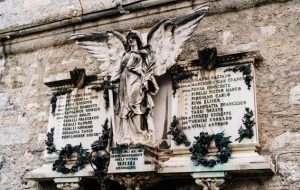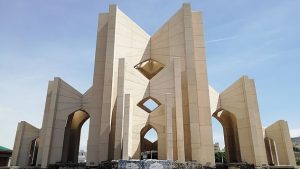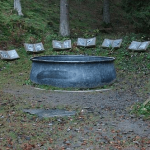 Our World
Our World  Our World
Our World  Movies and TV
Movies and TV The 10 Coolest Stars to Set Sail on The Love Boat
 History
History 10 Things You Didn’t Know About the American National Anthem
 Technology
Technology Top 10 Everyday Tech Buzzwords That Hide a Darker Past
 Humans
Humans 10 Everyday Human Behaviors That Are Actually Survival Instincts
 Animals
Animals 10 Animals That Humiliated and Harmed Historical Leaders
 History
History 10 Most Influential Protests in Modern History
 Creepy
Creepy 10 More Representations of Death from Myth, Legend, and Folktale
 Technology
Technology 10 Scientific Breakthroughs of 2025 That’ll Change Everything
 Our World
Our World 10 Ways Icelandic Culture Makes Other Countries Look Boring
 Our World
Our World 10 Ways Your Christmas Tree Is More Lit Than You Think
 Movies and TV
Movies and TV The 10 Coolest Stars to Set Sail on The Love Boat
 History
History 10 Things You Didn’t Know About the American National Anthem
Who's Behind Listverse?

Jamie Frater
Head Editor
Jamie founded Listverse due to an insatiable desire to share fascinating, obscure, and bizarre facts. He has been a guest speaker on numerous national radio and television stations and is a five time published author.
More About Us Technology
Technology Top 10 Everyday Tech Buzzwords That Hide a Darker Past
 Humans
Humans 10 Everyday Human Behaviors That Are Actually Survival Instincts
 Animals
Animals 10 Animals That Humiliated and Harmed Historical Leaders
 History
History 10 Most Influential Protests in Modern History
 Creepy
Creepy 10 More Representations of Death from Myth, Legend, and Folktale
 Technology
Technology 10 Scientific Breakthroughs of 2025 That’ll Change Everything
 Our World
Our World 10 Ways Icelandic Culture Makes Other Countries Look Boring
10 Scenic Burial Sites with Views to Die For
For many people, cemeteries and graveyards are places of grief and remembrance. For others, they’re spooky locations that are supposedly a hive of paranormal activity. But as well as being sad or scary, burial sites can also be scenic, with extravagantly designed tombs and stunning views of the surrounding landscape. Here are 10 burial sites around the world with killer views that would make a fantastic eternal resting place with tombstones tourists will be dying to visit.
Related: 10 Cemeteries You Wouldn’t Want to Spend the Night In
10 Varenna Cemetery, Italy

Lake Como is a popular destination for vacations in Italy, but few sun-seeking tourists know that it’s also the site of one of the most beautiful cemeteries in the world. Varenna Cemetery is a small burial site located right on the edge of Lake Como. It has unobstructed views of the brilliant blue waters of the lake and the mountainous terrain beyond.
The cemetery itself is cut into the hillside, with the larger mausoleums being set into the slope above, while smaller tombs line the walkway at the lake’s edge. A couple of hikes around the Varenna area pass through the cemetery, including one that leads to the impressive ruins of Vezio Castle. Still, its out-of-the-way location makes it a very peaceful cemetery to visit.[1]
9 Père Lachaise Cemetery, France
Established in 1804 by French military commander Napoleon Bonaparte, Père Lachaise Cemetery is a 108-acre (44-hectare) park in Paris that attracts three million visitors each year, making it the most visited necropolis in the world. Its draw is easy to see—70,000 tombs, many of which have been sculpted with artistic flair, are arranged among beautiful trees and shrubbery.
Many famous deceased people are buried in the Parisian cemetery. The most famous graves are writer Oscar Wilde’s, which is often covered in lipstick kisses, and musician Jim Morrison’s, which, though modest, is adorned with flowers and gifts from fans. Other photographic graves that people seek out include writer Georges Rodenbach’s, for a statue in his likeness dramatically bursting out of the tomb, and journalist Victor Noir’s, whose life-size bronze sculpture boasts an amusingly large trouser bulge that, if rubbed, is said to bring luck in fertility.[2]
8 Sunset Chapel, Mexico
Located in Acapulco, Sunset Chapel was built for two purposes: to celebrate marriage and to mourn the deceased. According to BNKR, the architectural firm that designed the building, this contrast between the beginning of a marriage and the end of life informed everything about the design. “Through this game of contrasts, all the decisions were made: Glass vs. Concrete, Transparency vs. Solidity, Ethereal vs. Heavy…”
The building was also designed to mimic the brilliant scenery of its surroundings, with the church-crypt combination being shaped to look like one of the huge granite boulders that dot the mountainside. To further utilize its location, it was built so that the setting sun during the equinox would perfectly align with the glass altar cross. The crypt can be found at ground level, while the chapel occupies the upper floor.[3]
7 Mausoleum of Poets, Iran

In the Iranian city of Tabriz stands the Mausoleum of Poets, an artistic and imposing building that houses the remains of deceased poets and other important figures. The structure is formed of impressive interlocking angular arches and combines modern and traditional styles. It’s the final resting place of more than 400 poets, mystics, activists, and politicians.
The Mausoleum of Poets took 10 years to build, being completed in 1982. But although the current building has only been open since the ’80s, the site has been home to many mausoleums over many hundreds of years. These buildings were unfortunately destroyed by various floods and earthquakes. It’s unknown exactly how long the location has been used as a burial site, but a couple of 14th-century texts mention a mausoleum on the land.[4]
6 St. Andrews Cathedral, Scotland
Ruined churches and their surrounding graveyards are often atmospheric places, but a particularly scenic example is St. Andrews Cathedral in Scotland. The cathedral and its nearby graveyard sit on the coast overlooking the North Sea. Although now a crumbling ruin, what remains of the huge building looms majestically over the gravestones.
Construction of the cathedral began around 1160, but it took hundreds of years to complete because of a storm in 1272 causing damage. Progress was then further halted because of the First War of Scottish Independence against England. The building was finally finished in 1318 and was consecrated in the presence of King Robert the Bruce. It was the largest church in all of Scotland and became the headquarters of the Catholic Church. However, it was abandoned in 1561 because of the growing prevalence of Protestantism.[5]
5 Chichicastenango Cemetery, Guatemala
While some cultures prefer graveyards to be austere, others like to inject a little color into mourning. In the Guatemalan town of Chichicastenango, the cemetery bursts with colorful crosses and mausoleums. The rainbow aesthetic of the cemetery isn’t just for show (although it is undeniably picturesque) but is actually part of the indigenous Maya tradition.
Different colors have different meanings: white is for purity, turquoise represents protection, and yellow signifies the sun. However, some people choose to break with tradition, opting instead to paint the tomb the favorite color of their deceased loved one. To keep the graves looking their best and brightest, they are cleaned and, if necessary, repainted each year during the Day of the Dead in early November.[6]
4 Neptune Memorial Reef, USA
Neptune Memorial Reef is an underwater cemetery where the dead can quite literally sleep with the fishes. Located just off the coast of Florida, the reef is the perfect place for families who want to scatter their loved one’s ashes at sea but still want a site to visit. According to Neptune Memorial Reef’s website, the process involves “carefully blending cremated remains with a natural concrete substance, which is then molded and secured within the various artistic structures, complete with an engraved copper plaque.”
The remains of multiple people can be combined into one placement, and cremated pets can even be added into the mix. People can visit by boat or scuba dive down to the reef for a fully immersive experience. Divers will get to view not only the stone artwork of the reef but also the various sea creatures that it supports. Once complete, the reef will stretch out over 16 acres (6.5 hectares) and will have room for the remains of 250,000 people.[7]
3 Makomanai Takino Cemetery, Japan
Okunoin cemetery is world-renowned for being not only the largest cemetery in Japan but also one of the prettiest due to its location among the serene trees of the Koyasan forest. But Okunoin isn’t the only Japanese cemetery with views worth visiting. Makomanai Takino Cemetery in Sapporo boasts a range of large and impressive statues for visitors to marvel at.
Lining the entrance road to the cemetery are around 40 stone replicas of the famous Moai heads found on Easter Island. The cemetery is also home to a full-size replica of Stonehenge, but the most impressive statue is the huge Buddha that sits within a hollowed-out hill. With his head peeking out of the top of the hill, the Buddha stands—or rather, sits—at a height of 44 feet (13.5 meters). Visitors can get a full view of the Buddha by passing through a tunnel under the hill, at the end of which sits the impressive statue framed by a halo of sky.[8]
2 Myra Necropolis, Turkey
Myra Necropolis is an incredible 4th-century BC Lycian burial site that is carved into the vertical face of a cliff. The ancient necropolis is technically divided into two: the ocean necropolis and the river necropolis. Although now faded, the rock-hewn tombs of Myra—some of which look like houses and others temples—were once painted in all the colors of the rainbow.
The most famous tomb at the site is the “Lion Tomb” (named after a carving in its facade of a lion fighting a bull), which contains eleven life-sized stone statues that are believed to represent the grave owner’s relatives. As well as being an amazing sight themselves, the tombs also have a brilliant view of the ruins of Myra below, including the well-preserved semi-circular theater and the Church of St. Nicholas.[9]
1 City of the Dead, Russia
Nestled in a valley in the Caucasus Mountains lies the small Russian village of Dargavs and its eerie adjoining cemetery, known as the City of the Dead. Comprised of 99 above-ground crypts, the ancient necropolis is framed on all sides by beautiful rugged mountains. Although a scenic resting place, the actual history of how these crypts came to be remains elusive.
It is thought that they may date back to the 13th century and the Mongol-Tatar invasion, with the crypts serving to conserve space after an increase in the number of dead bodies due to war. Another theory is that they were built by migrating Sarmatians who traditionally buried their dead above ground out of respect for the land. Plague epidemics during the 17th and 18th centuries saw the number of bodies laid to rest within the tombs rise sharply. There’s even evidence to suggest that infected people were quarantined within the crypts as they waited for death.[10]



